A thermostat is a handy device to control the functioning and efficiency of a heat pump. It helps to maintain the coolness or warmth based on the requirements. Heat pump thermostats are available in different sizes, shapes and variations. Some of the latest ones even come with smart features as well. If you are finding it difficult to decide which model to choose, then below factors can be helpful. Compatibility – One has to check whether the thermostat model is compatible with a heat pump system or not before making its purchase. Some thermostat models won’t support an HVAC system with a heat pump. So, it is a must to read the specifications clearly to make your purchase worthwhile. Types – There are three main types of thermostats available for heat pumps – mechanical, electrical and smart thermostats. Each type has its own set of benefits and drawbacks. You have to choose the type based on your requirement.
Mechanical models are the cheapest and standard form of thermostat in which you have to operate it manually, and won’t have any extra features. Electronic models let you program some settings like date, time, and schedules. They come with either automatic or manual switching. Smart model is a high-tech thermostat that is Wi-Fi enabled to get sync with the devices. They can be programmed with a mobile app, which makes it expensive than other types.
Installation & Wiring – The wiring for a heat pump is quite different from other HVAC systems. So, a thermostat you chose has to support the wiring required for a heat pump. Check the user manual and manufacturers specifications for its easy installation and wiring. Using the same information and after doing a thorough analysis on various products, we have enlisted some best heat pump thermostats. Also, we came up with a detailed “Buying Guide” that helps you a lot in selecting your perfect thermostat for your heat pump, as per your requirement.
7 Best Heat Pump Thermostat 2023
7 Best Heat Pump Thermostat Reviews
1. Google Heat Pump Thermostat
Best smart thermostat reviews Oxygen sensor reviews Thermostat Wire colours Best Line Voltage Smart Thermostats Best Air ionizer Reviews Smart air purifier reviews
Google’s Nest brand is known for making highly premium smart home devices that offer a lot of things to the user for a great experience, just like its heat pump thermostat. The Google Nest T3017US heat pump thermostat is present in the 1st position in this article as it offers the best overall experience to the user. This is simply due to the reason that you get all connectivity options with it, including WiFi and Bluetooth. Hence, you can easily use the companion smartphone app or any other voice assistant of your choice. Since this is a Google product, you get a premium build quality along with a 2-year long warranty with it. Speaking of the build, it offers a highly modern design that consists of a colored display in the middle and a dial around it for changing the temperature. Best Features:
Bluetooth and WiFi connectivity options Supports smartphone app and voice assistants 2-year long warranty
Pros:
Offers a high user rating Comes with a decent coverage area High power rating and temperature
Cons:
A slightly expensive thermostat
2. Ecobee Heat Pump Thermostat
Ecobee is another big name when it comes to smart heat pump thermostats for installing in your home that also offers a wide range of features and options to the user. Ecobee3 Lite is present in the 2nd position in this article as it offers two sensors along with it. These sensors can be installed in different rooms of your house for better temperature readings. Due to this, the automated functions of this heat pump thermostat will work better. Speaking of automation, it can even save up to 23% on your yearly electricity bill. If you want to control and use this smart thermostat, then it can be done quite easily as it offers both WiFi as well as Bluetooth. This is useful for using its included smartphone app and voice assistant support for ease of use while changing the temperature of your room. Best Features:
Bluetooth and WiFi connectivity options Supports smartphone app and voice assistants 3-year long warranty
Pros:
Includes two sensors in the box Saves on your electricity bill Offers multiple connectivity options
Cons:
Quite an expensive heat pump thermostat
3. Sensi Heat Pump Thermostat
Those of you who want their heat pump thermostats to last for a long time should consider Emerson as it makes one of the most durable and reliable options out there. This Emerson ST55 heat pump thermostat is present in the 3rd position in this article as it is the most durable and reliable option in this article. Apart from offering a great build quality, you get a 3-year long warranty with it. And you get this without paying extra for it as found in other premium heat pump thermostat options out there. It allows you to use this thermostat from either its smartphone app or using any voice assistant of your choice. This is possible due to the reason that you get WiFi connectivity in it. Its display is quite large and shows a lot of information to the user at once. Best Features:
WiFi connectivity options Supports smartphone app and voice assistants 3-year long warranty
Pros:
Highly durable and reliable model Offers a large-sized display Works with a smartphone app and voice assistant
Cons:
Very basic display and control layout
4. Honeywell Heat Pump Thermostat
Honeywell is a highly popular name out there when it comes to heat pump thermostats. Its products offer various smart features to the user without asking for an extra premium for the same. The Honeywell RTH6580WF heat pump thermostat offers all of the features and options to the user that you will ever need in a thermostat. It even comes with WiFi connectivity functionality. It can be used to set up to 7 days of programmable settings in this thermostat. All of this can be done using either its smartphone app or any popular voice assistant of your choice. Since Honeywell is a reputable brand, you get a pretty great build quality along with it. Although the 1-year warranty is a bit on the lower side for most users out there. Its large buttons are easy to press and allow you to easily navigate through the different options shown on its screen. Best Features:
WiFi connectivity options Supports smartphone app and voice assistants 1-year long warranty
Pros:
Great build quality Easy to use unit Connects with smart devices for a smart home experience
Cons:
Only a 1-year long warranty
5. Orbit Heat Pump Thermostat
Unlike other models mentioned in this article till now, Orbit’s heat pump thermostats are quite basic and do not offer any of the smart functionalities to their users. Orbit’s 83521 heat pump thermostat is quite similar to older models out there. Although it is the only pick in this article that comes with a total of 5 pieces in a single pack so that you can install one in almost all rooms of your home quite easily. You get a 3-year long warranty with this heat pump thermostat that is quite great when combined with the great build quality. Although, as mentioned earlier, this is not a smart heat pump thermostat. Instead, it uses the controls and display on the unit itself for changing different settings. Thankfully, the buttons are quite easy to press, and the display is easy to read due to its large size and decent brightness. Best Features:
Manual interface Controlled via buttons and display 3-year long warranty
Pros:
Easy installation process Comes with 5 units Long warranty for peace of mind
Cons:
Not a smart heat pump thermostat
6. Mysa Heat Pump Thermostat
As you can tell by the name, Mysa is another brand of home thermostat that makes smart options that offer smart connectivity features to the user for easily controlling the temperature of your home. This Mysa smart thermostat offers one of the most unique looking designs with an integrated LED display. While there are very basic controls on the unit itself, you get a full smartphone app as well as voice assistant support in this article. Both of these things can be used to control this thermostat over the WiFi network in your home. Since this is a Google product, you get a premium build quality along with a 2-year long warranty with it. Speaking of the build, it offers a highly modern design that consists of a colored display in the middle and a dial around it for changing the temperature. You also get a 2-year long warranty along with a great build quality in this model. Best Features:
WiFi connectivity options Supports smartphone app and voice assistants 2-year long warranty
Pros:
Works with most voice assistant Great looking design Great build quality
Cons:
Basic controls on the thermostat unit
7. Lux Products Heat Pump Thermostat
Lux Products can be another great option if you want a basic heat pump thermostat without any smart options for saving on the price tag or for using with an older heat pump unit in your home. The Lux Products TX9600TS heat pump thermostat is a non-smart unit that does not offer any connectivity options. Instead, you get a large display on the unit for checking its different settings. But unlike other non-smart models, this one comes with a touchscreen that is slightly better than using buttons while using a thermostat. You can use the touchscreen to either change the settings or make programmable plans in this heat pump thermostat. Just like most other options out there, this one also comes with a 3-year long warranty for peace of mind. Although its build quality is just average and could have been much better. Best Features:
Manual interface Controlled via buttons and display 3-year long warranty
Pros:
Uses a touchscreen for control Fully programmable settings Easy to use thermostat unit
Cons:
Average build quality
How to Choose the Best Thermostat for a Heat Pump:
Let’s take a closer look at the factors you need to consider while shopping for a heat pump thermostat.
1. Compatibility:
Compatibility is the primary factor to consider when choosing a thermostat for your heat pump. As it ensures that the thermostat will work properly with your heat pump. Remember that not all thermostats are compatible with HVAC systems with a heat pump. So, it is essential to intently check the specification of the thermostat model before making its purchase.
2. Installation and Wiring:
The wiring needed for a heat pump is quite different from other HVAC systems. So, a thermostat you chose must support the heat pump wiring. How do we understand whether the thermostat wiring will support the HVAC system/heat pump or not? For this, you have to seek out the manufacturer’s specifications or simply check the model number online. Thus, it will give an idea of whether it is recommended for the heat pump system or not. Taking a photo of existing wire labels while replacing an old one will evade confusion. While installing a new one, you should follow the installation manual to understand the instructions and install them easily. Still getting confusion on its installation, then simply hire a technician.
3. Emergency Heating in Heat Pump:
Is the heat pump owns an emergency or auxiliary heat option? If it owns, then you won’t have any choice other than selecting a thermostat model supporting the heat pump. Generally, we find various thermostats that work well with a heat pump, yet are not suited with an emergency or auxiliary heat system. It is essential to choose a thermostat that effectively supports heat pumps with aux. heat. This type of selection is applicable only when the heat pump is compatible with the auxiliary heat.
4. Wi-Fi Accessibility:
Most heat pump thermostat models feature Wi-Fi accessibility or wireless access that let you connect to your workplace network. You can easily use them via mobile app, voice command or third-party control to run the heat pump. You can even program every feature with this Wi-Fi option without touching the thermostat manually. So, prefer to purchase a wireless-enabled thermostat for controlling these thermostat units.
5. Design and Aesthetics:
One has to choose an aesthetically designed thermostat having styling sleek, controls, and faceplate designs. It should match with your office or home décor. A few thermostat models are not at all aesthetically pleasing with their square block on the wall which won’t light up. So, pick a thermostat with really good designs.
6. Auxiliary Power Supply:
However, it is a bit challenging for the heat pump while trying to reach the selected temperature in extremely cold weather. If the air-source heat pump (primary heating mode) fails to meet the heating requirements or temperature settings, then the thermostat turns on a secondary heating method automatically, which uses an auxiliary or electric heat strip. If you need instant heating in the home, then choose a secondary heating mode as the primary mode. But remember that it consumes more electricity and thereby costs you a lot in the bill, and disables the primary heat pump as well.
7. Programmability:
The electric and smart heat pump thermostats are programmed that make your life easy to use. If you are interested in it, then avoid the mechanical ones. This programmable model will adjust the temperature according to the day of the week or the time of the day.
8. Connectivity Options:
A lot of options mentioned in this article are smart ones that let you use them along with your smartphone. But to ensure this, you have to check the connectivity options offered by the model that you are purchasing. While high-end options come with both Wi-Fi and Bluetooth connectivity, others might have just buttons and display on the unit itself.
9. Types:
The thermostat for your heat pump comes in three variants – mechanical, electrical, and smart. Each one has its set of pros and cons. Knowing them in detail will help in your decision process.
Mechanical (or) Non-Programmable Thermostat –
Mechanical thermostats are a standard, and less expensive type of thermostat, in which there isn’t a lot of functionality. After connecting to wiring and selecting the operation mode, which is either heat only, cool and heat (or) cool, heat and fan. You have to manually operate the thermostat on/off. Initially, turn it on and slide a temperature selector or a dial to the desired temperature range. Then the thermostat will turn on the system continuously and off to keep the house at the desired temperature.
Electronic (or) Programmable Thermostat –
Electronic thermostats are a better version than mechanical models, as they come with a digital display (with or without a touch screen) and some extra features. It let you use them as a mechanical thermostat (set the mode or temperature and turn on/off) or program them as well. They use the time and date that you set as a base for programming. Simply scroll through the days, and hour ranges in those days to set a schedule. Within the scheduled times, the electronic thermostat turns on/off the system to maintain the set temperature. Also, program these thermostats to turn off when you are not there at home and turn on when you come home.
Smart Thermostat –
A few premium models offer extra features like geofencing that activate or disable the system when you enter or go away a set radius of the home. Also, you can program the system to turn off all day while you are at work (no one in the home) and gets turn on when you come within 2 miles of the driveway. Even though these smart models are most expensive compared to manual or electronic models, yet they offer high energy efficiency and the best control over the device.
Verdict:
Mechanical thermostat won’t have functionality, in which you have to set the temperature and turn on/off the device. Electric thermostat lets you program the time and date schedules, and has automatic or manual switching. Smart thermostat is connected wirelessly to your mobile or smart home devices. Thus, it let you schedule, program, and operate the thermostat anywhere via its app.
10. Number of Cooling and Heating Stages:
Use staging to increase the efficiency of HVAC systems, as staging will allow the system to achieve the chosen temperature progressively. So, to grab the maximum benefit from these systems, opt for a thermostat supporting most stages. However, most thermostats support one cooling and one heating operation and labeled as 1H/1C – one cooling stage and one heating stage support (on/off). Most brands provide multistage thermostats to support more than just a cooling and heating stage. Yet also use secondary methods, look for an effective thermostat with a greater number of cooling and heating stages, such as 2H/2C, 3H/3C, etc.
11. Support for Heating and Cooling:
Usually, heat pump thermostats are programmed for managing both cooling and heating on the same system. Here refrigeration process is used by the heat pump for cooling and heating purposes. With its reversing valve, a heat pump will facilitate heating to cooling and cooling to heating. This valve is energized by using 24-volts for the cooling cycle.
12. Price:
One should set the budget range and select the right one among several models in the market. However, the price range is affordable that depends on their types, and various features they offer. The mechanical thermostats cost a few bucks, and smart thermostats cost you hundreds, while electric thermostats fall in between the price range of these two types. If the budget is low, you can go with a simple programmable thermostat for the heat pump, which is enough to provide efficient performance. Also, it provides adjustable temperature at your convenience.
13. Warranty:
One has to check the warranty period offered by the manufacturer before making the product purchase. Most thermostat models come with a minimum of a 1-year warranty, while a few models offer a 2 years, 3 years, or 5 years long warranty. Prefer to buy a heat pump thermostat that offers long term warranty, and also check its brand, build quality, and customer service offered by the manufacturer.
Some Key Features to Seek Out for Smart Thermostat:
Based on the technology, smart thermostats are quite different and need to consider a few factors specially than other two types. Here are those factors.
1. Programmable:
You can easily schedule programmable thermostat as per your requirements. it lets you choose and set the temperature for different days (weekdays and weekends) or different day times. Here are a few programmable modes found in a smart thermostat.
Daily – Choose a daily schedule to make a thermostat repeats subsequently 24 hours or simply a day. 5-2 Days – Set a schedule for 5 weekdays and set other schedule only for weekends (Saturday & Sunday). 5-1-1 Days – Program a schedule for 5 days and a separate schedule plan for weekends (on both days). 7 Days – Set a scheduled program for each weekday as per your requirement or preferences.
2. Geo-Fencing:
It will save a lot of energy with its away and home modes. It can be operated with a smartphone app that let you fix an imaginary fence all over the home. If you cross the line, a thermostat turns off/on as programmed. Thus, you can get into the home in a comfortable atmosphere and also prevent cooling or heating an empty home.
3. Safeguard Equipment:
Most often and unusual switching on/off of the HVAC system results due to short-cycling. However, the system won’t have sufficient time to switch on/off, which causes damage to the system. These smart thermostats can delay providing proper time for the system to shut down or start up completely to prevent this condition. Thus, it keeps the equipment safe from damages.
4. Remote Control:
One can easily control the thermostat operations with a remote without any need to accomplish them manually. Also, it let you change the settings anytime and from anywhere, and the smartphone app allows you to manage and control the thermostat settings, like creating schedules, switching the thermostat on/off, changing temperature preference, and so on. One can download the app easily for Android or iOS smartphones.
Benefits of Using Heat Pump Thermostat:
The advanced thermostat offers several benefits, which makes it essential to purchase and use it at home. Here are some of the benefits mentioned that let you know why do we use a thermostat for your heat pump. Saves Energy Bills – A proper usage of a thermostat will save electricity bills with its programmable feature. Their HVAC system will adjust the home temperature automatically and make you feel comfortable at any time. Comfortable Scheduling – It offers three types of programmable thermostats, in which you can schedule a convenient option among them as per your requirement.
7-day Thermostat Model: A quite common and suitable option for most households where it maintains a different schedule every day. 5 – 2 Model: In this setting, we can schedule separate settings on 5 weekdays and 2 weekends. 5 – 1 – 1 Model: It is the perfect option for families having multiple schedules for 5 weekdays and each weekend that is scheduled differently.
Remote Temperature Control – You can easily control a Wi-Fi accessible thermostat via your smartphone or tablet. Thus, it let you efficiently control the system whenever you need it without going near the thermostat. Controls Humidity, Light Sensors and Motion – A temperature adjustable thermostat (humidifier or dehumidifier) will automatically adjust to ideal humidity level (30% – 50%) to keep in a comfortable position. Thereby it won’t let you suffer from several respiratory problems like asthma or allergies. Precise, Controlled Temperature – Usually, programmable thermostats (+/-1° deviation about temperature) are more accurate than analog thermostats (+/-5° variance). However, analog ones consume more energy and raise your power bill. So, it’s better to replace an analog thermostat with the programmed thermostat. Lockable Setting – Few thermostat models feature lockable settings of temperature that let you lock the temperature level. Thus, you get precise control over the thermostat and won’t let anyone unexpectedly change the temperature. Enhance the Home’s Efficiency – A perfect thermostat will allow the home to be more efficient throughout any season. Thus, it lets your appliances to last longer by utilizing your resources efficiently. So, they control the temperature and make you live relaxed and comfortably.
How does this Heat Pump Thermostat Work?
A heat pump thermostat is meant to measure and maintain the appropriate indoor temperature, especially in the cold season. Initially, you have to connect the thermostat to the HVAC system by proper wiring. Most thermostats are programmable, in which you can set the schedule, and it works best for the rest. A few premium models get switched off when no one is there to save energy (energy-efficient) and consumes less power. Moreover, it features a mobile app that makes it compatible with almost all iOS and Android devices. This mobile app will let you get complete control over the thermostat from anywhere, including the beach, office or camps. Based on the input criteria (like present temperature, time or geofencing), the thermostat will turn on/off the heat pump. While living in sub-freezing winter climates, the temperature where most of the heat pumps feature auxiliary or emergency heating functions, then use a thermostat with heating mode. Set the appropriate temperature when the temperature is fallen from programmed targets, then the thermostat will switch on the pump, and after the temperature is reached, it turns off the heat pump/HVAC system. However, the thermostat sends an electric signal to the heat pump, and the switching is triggered by specific times or schedules of the day. So, keep in mind that the thermostat will work with specific types of heat pumps before buying your best thermostat for the heat pump.
Tips to Use Thermostat:
Here are some tips that let you know how to grab the most benefits from the thermostat while using it for a heat pump.
If your thermostats run with batteries, then it is a must to perform a periodic check to prevent any system failure with its less battery charge. Though thermostats come with different features like hold, temporary, and vacation settings. If you are out on vacation or go out of the home, then prefer to select a vacation mode. While staying at home, then choose a temporary mode. Choose a hold feature to change the setting and hold the thermostat that won’t come into workable mode until a 24-hour cycle. Select an energy-saving setting on your thermostat for not less than 8 hours continuously for getting maximum efficiency.
Maintenance Tips of Thermostat:
It is a must to do the regular maintenance of the thermostat to make it use effectively. Also, spending some time on regular maintenance of the device will enhance its longevity and reliability. Here are some of the maintenance tips that you have to follow regularly.
Adjust Temperature Setting – A cooling temperature is quite different from a heating temperature. So, it is essential to set up the apt temperature that not to be changing it often. Clean Air Filter Regularly – A clean air filter ensures the smooth working of the heat pump and keep it safe from any damages. Also, it let you enjoy a striking performance from the thermostat in all seasons. So, it is a must to clean the air filters periodically. Keep a Clean Outdoor Unit – It is mandatory to clean the outdoor area after every season. If not, the dust, debris, and dirt particles will accumulate on the outdoor unit during each season. Also, don’t plant anything within 4 – 5 feet of the outdoor unit. Rinse the Condenser – If there is any build-up of dust or debris after every season, then give a thorough wash to the condenser. Ensure to turn off the system before rinsing and use a hosepipe but not at high pressure for rinsing the condenser.
How to Install a Thermostat?
Though a thermostat installation is easy and simple, yet remember that this process is not the same for all models. We recommend you check the user manual of the device to install this thermostat. A few models need professional assistance for their installation. Irrespective of the type of heat pump thermostat, here is the detailed installation procedure for most thermostats.
Initially, turn off the breaker that controls the heat pump and any connected devices. Take away the faceplate of the existing thermostat and clean any debris or dust for a clear vision of wires. Take a photo (or) label the wires to note down the colors and where they are connected. Then remove the wires from your old thermostat and take out the base plate from the wall as well. If you are looking to paint or repair the drywall, then you can do it now. Then run wires through the back of the new wall plate and secure it to the wall. It’s time to use the photos or labels set earlier for connecting the wires properly to the terminals in the new thermostat model. However, the excess wire should be driven back into the wall and then attach a new faceplate. Flip the breakers back on to restore the power for the thermostat. The thermostat will light up as an indication that it is connected properly and the setup sequence will begin (for smart or electronic thermostat). Turn on the thermostat to ensure everything works well. Test it once before you make it use regularly.
Understanding Heat Pump Thermostat Wiring:
A heat pump usually works as a heater and air conditioner that offer you comfortable year-round, irrespective of the season. They use a refrigeration process to provide two-way climate control (heating and cooling). An HVAC thermostat comes with 4 wires – call cool, call heat, power and fan along with AC wire. While heat pump thermostats come with a wire for calls to cool/heat, one for auxiliary heat and a couple of extra wires to install. You can use the changeover wire/reversing wire to control any changes in reversing valve that switches from heat to cool. The emergency heat wire gets deactivates the primary heat pump will ensure the secondary heat source takes over. It is used in an emergency like if you have any problem with this heat pump.
Thermostat Troubleshoot and their Resolution:
With various individual systems, it is quite common to cause problems with a heat pump. Consider a thermostat if something is not working properly. Usually, the thermostat shows some problems due to various issues, and it is simple to diagnose. Here are a few things that you have to verify some troubleshoot and its repairs.
Stop Working or Show Less Performance – Improper connection, dead batteries, or blown fuse are primary reasons that make a thermostat won’t work properly. Both mechanical and electrical functions interrupt if its internal components get dirty. Then clean them with a soft brush periodically, but won’t use any wet items to clean the thermostat. An old model shows poor performance. Most thermostats use a battery to run the screen or body. If the battery dies or does not have sufficient power, then the electronics inside will not turn the thermostat on. It is a must to check whether the thermostat’s working function quite often, especially if you find any defect in its functioning. Check the thermostat wiring by removing the faceplate and connecting the red wire (power) to white wire (heat). If the system comes on, then the thermostat is bad and not working effectively. Due to dust and other debris, the wires of the mechanical thermostat get shorted and thereby fail the functioning of the thermostat. So, clean the terminals and wires properly and test the thermostat again for its effective working.
How to Set a Thermostat to Save on Electricity?
Usually, an HVAC system is considered as a massive drain on energy consumption and thereby raise your monthly power bill. So, we recommend following a few things that help you to control these costs effectively. An even setting on temperature has to be maintained of the thermostat. Also, this setting has to be low but not too low that makes you feel uncomfortable. The recommended setting should be like this – for heating set between 68° – 71°F, while cooling temperature should be 76° – 78°F. Investing in a smart thermostat is the best way to save your monthly power bill, as they begin to run the system when required and maintain the proper temperature for a long time. A smart thermostat can easily save 20% on the overall power bill, and claims 33% or more in yearly savings.
Conclusion
While you can simply install a central heat pump in your house and start using it right away, that is not the best thing to do. This is due to the reason that you will have higher electricity bills due to lower efficiency and less comfort since you cannot change the temperature. Hence, you need to get one of the multiple best heat pump thermostats mentioned in this article. In order to help you in choosing the best one, we have mentioned their major features and options along with a detailed buying guide. In fact, here are some of our recommendations if you are in the market for a new heat pump:
Those of you who are on a budget can simply go with the Lux Products heat pump thermostat, as it is the cheapest option here. While it does not have any wireless connectivity options, it offers a large touchscreen that is easy to use. You can change a lot of settings using it easily. If you do not have any budget restrictions and want one of the best smart heat pump thermostats, then you should check out the Google heat pump thermostat. It offers all connectivity options along with a modern-looking design that has a screen in the middle. The Sensi heat pump thermostat is the most durable and reliable one in this article that is also a smart one since it supports a smartphone app and voice control. You get a 3-year long warranty with it that is great to have along with the great build quality.
Make sure to share your thoughts in the comments section. You can also post any questions down there if you have any! Comment * Name * Email * Website
Δ



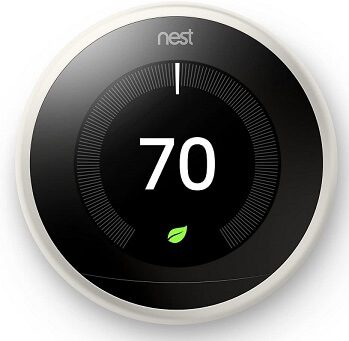
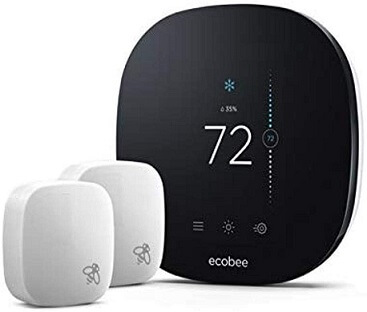
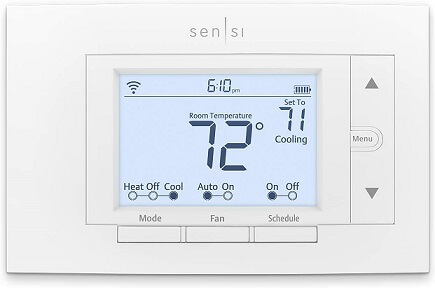
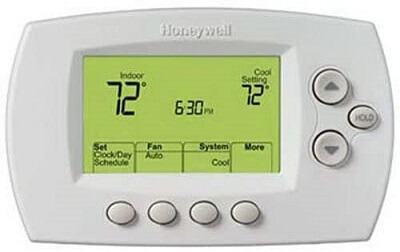
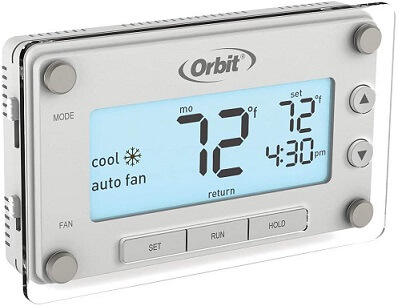
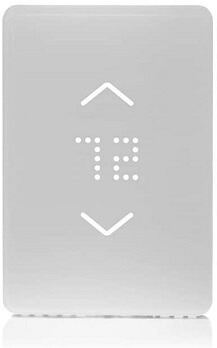
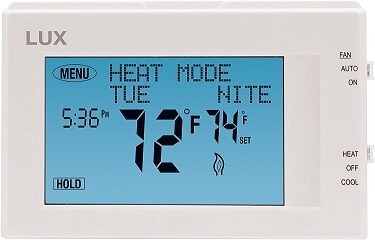


![]()